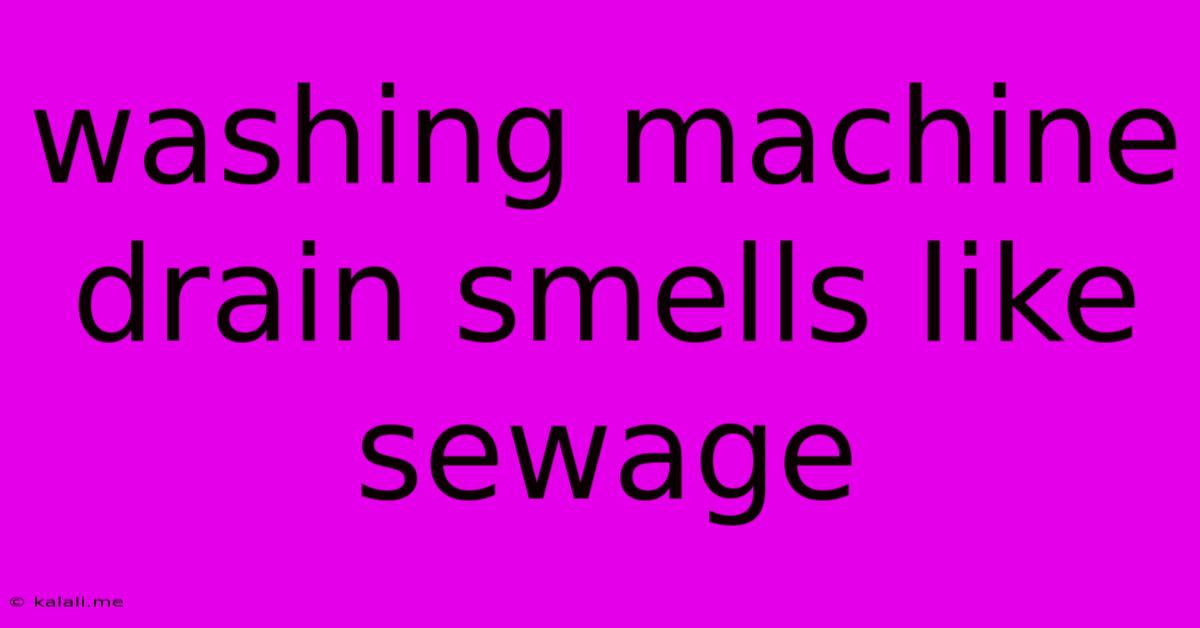Washing Machine Drain Smells Like Sewage
Kalali
May 22, 2025 · 4 min read

Table of Contents
Washing Machine Drain Smells Like Sewage: Causes and Solutions
A foul odor emanating from your washing machine drain, reminiscent of sewage, is undeniably unpleasant. This isn't just an olfactory issue; it indicates a potential plumbing problem that requires immediate attention. This article explores the common culprits behind this nasty smell and provides effective solutions to eliminate it, ensuring your laundry room remains fresh and clean. We'll cover everything from simple DIY fixes to when you might need to call a plumber.
Why Does My Washing Machine Drain Smell Like Sewage?
The musty, sewage-like smell coming from your washing machine drain usually points to a blockage or a problem with your plumbing system. Here are some of the most frequent causes:
1. Clogged Drain Line: The Usual Suspect
This is often the primary reason. Hair, lint, soap scum, and other debris can accumulate in the drain line, creating a perfect breeding ground for bacteria and causing that awful smell. The slow draining of water from the machine could also be a symptom.
2. Sewer Gas Backflow: A More Serious Issue
A more serious problem is sewer gas escaping into your washing machine drain. This occurs when there's a blockage further down the line, a faulty vent stack, or a broken P-trap (the curved pipe under your sink or washing machine). Sewer gas carries harmful bacteria, so this needs prompt professional attention.
3. Standing Water: A Breeding Ground for Bacteria
If water sits in the drain line for extended periods, it provides the perfect environment for bacteria to multiply, leading to the unpleasant odor. This can be due to a slow drain or a poorly ventilated area.
4. Dirty Drain Hose: Often Overlooked
The drain hose itself can become coated with grime and bacteria, contributing to the foul smell. Cleaning or replacing the hose might be all you need.
5. Dryer Vent Issues (Indirect): Sometimes it’s related
While seemingly unrelated, a clogged dryer vent can create back pressure in the plumbing system, indirectly affecting the washing machine drain. A blocked dryer vent needs to be cleaned regularly for efficient operation and to prevent potential plumbing issues.
How to Fix a Sewage-Smelling Washing Machine Drain:
Before attempting any fixes, always disconnect the power to the washing machine for safety.
1. Check and Clean the Drain Line: A DIY Solution
First, visually inspect the drain hose and the area where it connects to the standpipe. Look for visible clogs. You might be able to remove some debris with a wire hanger or a plumbing snake.
2. Use Baking Soda and Vinegar: A Natural Cleaner
Pour a mixture of baking soda and vinegar down the drain. This creates a fizzing action that can help break down organic matter and eliminate odors. Let it sit for 30 minutes to an hour, then flush with hot water.
3. Check and Clean the Drain Hose: Easy Maintenance
Detach the drain hose from both the washing machine and the standpipe. Inspect it for clogs and clean it thoroughly with a brush or by running hot, soapy water through it. If it’s severely damaged or old, consider replacing it.
4. Address Sewer Gas Backflow: When Professional Help is Needed
If the smell persists despite cleaning, it's likely a problem with the plumbing system itself. This is where professional help is crucial. A plumber can identify the source of the sewer gas leak and perform the necessary repairs, such as clearing a blockage or fixing a faulty vent.
5. Improve Ventilation: A Simple Prevention Step
Ensure adequate ventilation in your laundry area. Good air circulation can help prevent the buildup of moisture and odors.
Preventing Future Sewage Smells:
Regular maintenance is key to preventing this issue:
- Clean the lint filter after every load.
- Regularly check and clean the drain hose.
- Use a washing machine cleaner periodically.
- Ensure proper ventilation in the laundry area.
- Schedule regular plumbing inspections.
By addressing the root cause of the sewage smell and implementing preventative measures, you can keep your washing machine drain fresh and odor-free. Remember, if you are unsure about any of these steps, it's always best to call a qualified plumber to avoid further damage or health risks.
Latest Posts
Latest Posts
-
What Does The Bible Say About Pork
May 22, 2025
-
You See A Boat Filled With People
May 22, 2025
-
How To Get Rid Of The Smell Of Diesel
May 22, 2025
-
Why Is My Cat Staring At The Wall
May 22, 2025
-
Why Does Propane Have A Low Boiling Point
May 22, 2025
Related Post
Thank you for visiting our website which covers about Washing Machine Drain Smells Like Sewage . We hope the information provided has been useful to you. Feel free to contact us if you have any questions or need further assistance. See you next time and don't miss to bookmark.